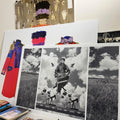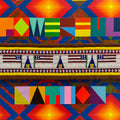Contemporary Native Artists and the 'Cultural Corral'
By Chadd Scott on
I interviewed glass artist Preston Singletary (b. 1963; Tlingit) last month about an exhibition of his work detailing the Raven story on view now at the Oklahoma City Museum of Art. During our conversation, he shared an expression with me I’d not heard previously: “Cultural Corral.”
That term was coined by Hopi glass artist Ramson Lomathowama (b. 1953), a friend of Singletary’s.
“It's a colonial point of view where people would like to keep the Native culture frozen in time,” Singletary said. “We should be allowed to evolve and expand our worldview, even in the context of our culture, and adopt new materials, new tools.”
“Cultural Corral.”
Restricting the freedom and imagination of Indigenous art like corralling a horse.

“Native culture is often governed by an anthropological point of view,” Singletary explained. “As artists, and as our culture has gained more support and acceptance, we are declaring who we are. My work is not traditional and so people who are concerned with history say, ‘it was never done this way before; how does it fit in?’ People struggle with the idea of categorizing it.”
After a conventional upbringing and training in glass art, Singletary began experimenting with the idea of connecting glassmaking to his cultural background in the late 80s. The sculptures and masks he started producing were common in wood, but unprecedented in glass.
For doing so, he experienced resistance along his path to becoming one of the world’s foremost glass artists. Resistance both for revolutionizing his medium – glass art never explored Native subjects previously – and for revolutionizing his subject matter – Native viewpoints were never explored in glass art previously.
In doing so, he became an innovator in both, escaping the cultural corral.
Just like Rose B. Simpson (b. 1983; Santa Clara Pueblo) whose rough, androgenous, life-size clay figures look nothing like the pottery for sale out front of the Palace of Governors in Santa Fe. Terri Greeves’ (b. 1970; Kiowah Indian Tribe of Oklahoma) did it with her beaded sneakers and stilettos. Nicholas Galanin (b. 1979; Tlingit and Unangax̂) got out thanks to his text-based installations. Nothing Cannupa Hanska Luger (b. 1979; Mandan, Hidatsa, Arikara, Lakota) does fits in the “Cultural Corral.”

Jeffery Gibson (b. 1972; Mississippi Choctaw/Cherokee descent) has raced all the way from the “cultural corral” to the 2024 Venice Biennale on the back of his beaded punching bags.
While each of these contemporary Native artists – every one (and a dozen more) now a fixture in major museums across America – was influenced and references so-called “traditional” or “customary” Native art in their work – it’s in their DNA – where they’ve taken their careers has been previously uncharted territory.
And they’ve gotten pushback for it along the way.
Many Native art collectors, curators, museum officials, gallerists, market judges, and even some fellow artists want Native art to remain what Native art has always been. But nothing which fails to evolve survives and, fortunately, resistance is diminishing.
These present-day “corral escapers” follow in the footsteps of T.C. Cannon (1946-1978), Fritz Scholder (1937-2005) and George Morrison (1919-2000) whose paintings combined Native heritage with Modernism during the 1960s and 70s. They follow Oscar Howe (1915-1983) whose dynamic, graphic, movement-filled paintings from the 1950s remain without comparison. Of Charles Loloma’s (1921-1991) astonishing jewelry designs that remain futuristic 60 years after their creation and 30 years following his passing. Of Roxanne Swentzell (b. 1962; Santa Clara Pueblo) who helped bring the figure and enormous scale to clay in the early 2000s.
There will always be a place for “the old ways” in Native art. Silver and turquoise jewelry, blankets and weavings, pottery, beadwork the way it’s been done for centuries. Good, there should be. Continuing those practices is equally as important as expanding them into never-before-considered ways.
Room exists for both.
The customary or contemporary conversation is not an either/or, it’s a both/and.
The corral gate is open.




